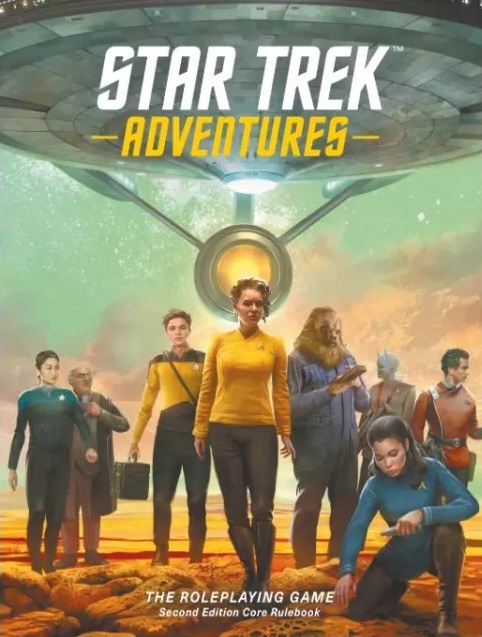by Modiphiüs Entertainment
“Space, the final frontier…”
These were the words which helped to capture countless imaginations, stretching from its origin in the sixties into the modern era. Star Trek has earned its place in the nerd pantheon as a science-fiction universe that tells the story of an optimistic future of abundance, diversity and exploration. And while it is no surprise to see such a property adapted to the tabletop gaming space, Star Trek Adventures: Second Edition is an interesting implementation of the big ideas of Star Trek.
In addition to carrying much of the “deep lore” of Star Trek in its pages, outlining the various aliens, planets and events of the universe, there is likewise an engaging system of play that emulates the collective nature of the franchise. As each player acts in the roles of the various “departments” of the crew (Command, Conn [piloting], Engineering, Security, Medicine and Science), they are always being driven forward to solve a greater problem that they would not be able to do alone. Especially in the operation of the iconic Star Trek starships, all players are expected to work cooperatively in their specialized roles in order to save the day.
One of the most interesting aspects of Star Trek Adventures is the character generation process, which is less about rolling dice and plugging numbers into slots and is more about telling a story about how your character got to their particular place in life. Character generation is handled by selecting a species and going from birth through their life into the present, outlining their specialities, their talents and life experiences and assigning values and specialities from those experiences. It is a surprisingly intuitive process that helps flesh out a character organically rather than through min-maxing and number-crunching.
Beyond the player-characters, however, the game encourages the creation of “supporting characters” which might otherwise fill in the gaps that the players haven’t covered. Because while classic Star Trek might have had the big names like Spock or Captain Kirk, the Enterprise always had a full complement of crew to help support those names. And, in Star Trek Adventures, even the ships themselves fit onto the role of a “character” as each ship has their own stats, strengths and weaknesses. The ship itself, in some capacity, helps players to solve problems through inherent bonuses. This mechanic helps to encourage engagement and investment in the players’ ship and really makes it hit home when the ship is damaged or malfunctioning (as often happens in the depths of space in Star Trek).
If there are any objections to be made about Star Trek Adventures it is undoubtedly a thick read. The first three chapters of the book are dedicated to getting non-Trekkies up to speed on the universe and lore of the world. And even when the “crunch” of how to roll and play the game is properly described, the rule explanations might require a bit of bookmarking and flipping back and forth to fully appreciate how the game flows in regular play. It is a simple enough system, but a unique one that might require some experimentation to properly appreciate. And while it is leaps and bounds improved from its first edition counterpart, its newness means that supplementary material is going to be scarce.
But to any seasoned tabletop roleplayer and Star Trek aficionado, I would strongly recommend cracking this book open and flipping through it to see if it sparks interest in your playgroup. You might check out a “real play” session or two on YouTube or Twitch and see if this game is for you or not. Like Star Trek teaches us, you never know what you’re going to find unless you get out there and explore!



